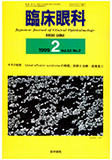Japanese
English
- 有料閲覧
- Abstract 文献概要
- 1ページ目 Look Inside
拒絶反応のハイリスクと考えられる全層角膜移植術例26名27眼に対し,シクロスポリン全身投与を術後平均5.4か月行い,長期予後と副作用をシクロスポリン不使用の対照群(57名57眼)と比較した。シクロスポリン投与中に内皮型拒絶反応が2例,中止後に6例出現した。拒絶反応非発生率はシクロスポリン投与群,対照群間に有意差がなく,移植片透明治癒率はシクロスポリン投与群で有意に低下していた。一過性BUNまたはクレアチニン値上昇が7例,GOTまたはGPT値上昇が4例あったが,重篤な副作用はなかった。短期的なシクロスポリン全身投与は,ハイリスク全層角膜移植例に対し拒絶反応抑制および透明性維持への長期効果を示さなかった。
We treated 27 eyes in 26 patients by systemic cyclosporine following high-risk penetrating keratoplasty for an average of 5.4 months. The longterm outcome and side effects were compared with another series of 57 eyes in 57 patients who did not receive cyclosporine. Endothelial rejection developed in 2 cases during cyclosporine treatment and in 6 cases after discontinuation. As side effects, transient elevation in blood urea nitrogen (BUN) or creatine developed in 7 cases. Increase in GOT or GPT developed in 4 cases. Severe side effects were absent throughout the series. The rate of rejection-free graft survival was similar between the treated and the control group. The control group showed a significantly higher rate of graft survival than in the treated group. Systemic cyclosporine thus did not reduce the incidence of rejection nor improve the rate of graft clarity in high-risk penetrating keratoplasty.

Copyright © 1999, Igaku-Shoin Ltd. All rights reserved.


